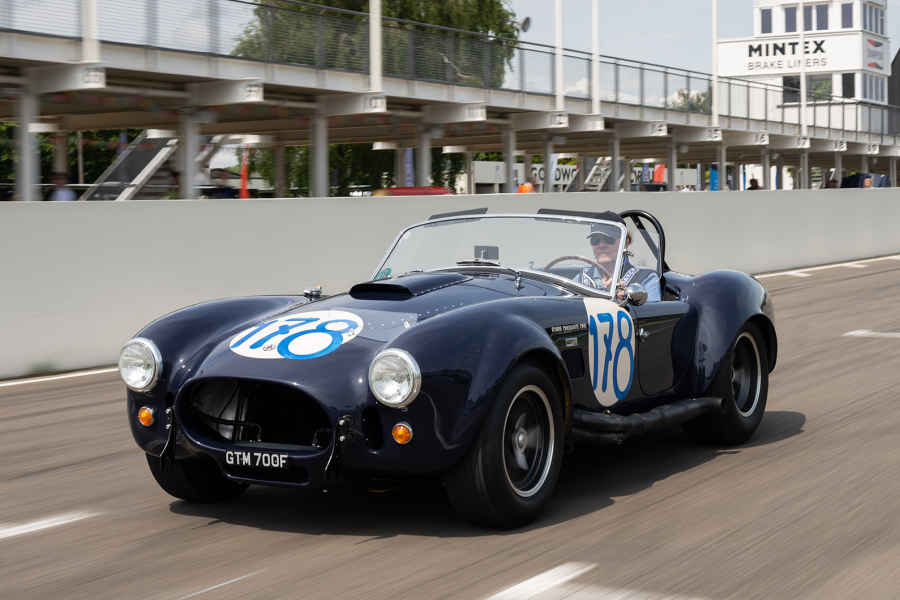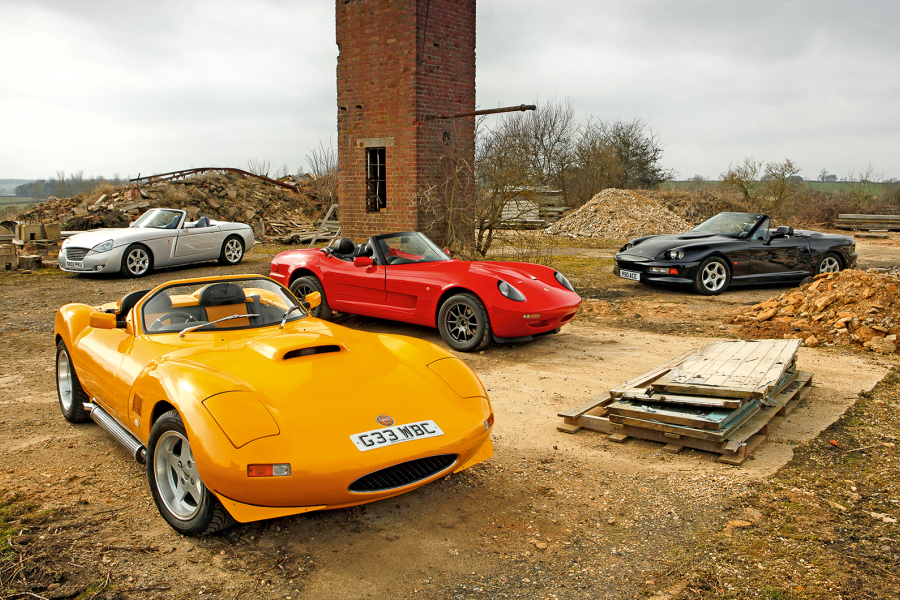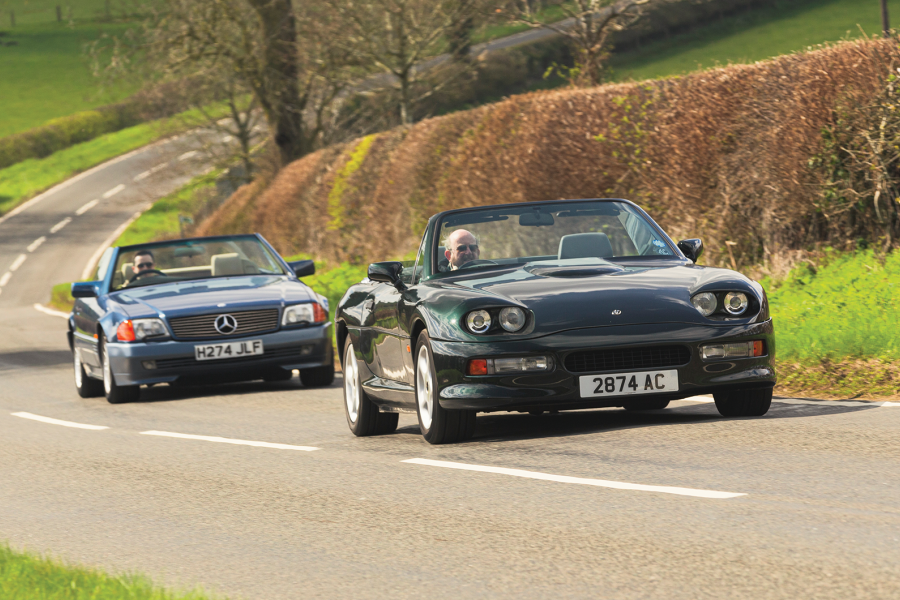The dash is different from earlier examples, with key dials grouped centrally in a semicircle, and warning lights and indicators arranged in a smaller mirror-image shape ahead of the wheel.
It’s a simple yet beautifully crafted interior, with burgundy leather and carpets set off by aluminium and painted-silver detailing.
The Superblower’s chassis is a well-balanced mix of compliance and agility
The noise brims with attitude even if it isn’t quite as boisterous as a Lightweight, yet the supercharger isn’t immediately obvious: any whine is damped into the background, but the belt-driven forced induction keeps fizz in the throttle in a way a turbo can’t.
Breach 2000rpm, though, and you feel the kick to the performance and a real punch through to 6000rpm, by which point things are moving at a furious lick.
It’s a MkIV with a fast-forward button. This gearshift is a little more knuckly than the Lightweight, but there’s still a tight mechanical feel, fantastic brakes and a chassis that sits somewhere between the MkIV and Lightweight in its combination of softness and eagerness to turn.
A Superblower also does a better job of putting its power down than the MkIV, something apparent both off the line and when you feed in the throttle during cornering. This is a nicely balanced package.
Inside the Superblower is a bespoke dashboard layout
While the Superblower maximised performance and profit, the CRS was all about accessibility.
Launched in 1998 at the London Motor Show, the CRS – for Carbon Road Series – marks the biggest change in philosophy of all the cars here (blue again, this time identified by twin black roll hoops).
“Lubinsky could see the big market for replicas,” recalls Fisher. “He wanted a car positioned below the MkIV to tap into that. To do that he had to reduce costs.”
An alternative to the handbuilt aluminium body was key, and the solution was a MkIV chassis with a carbonfibre shell produced by Pro-Tech Motorsport (an outfit affiliated with radio DJ David ‘Kid’ Jensen’s F3000 race team).
This car’s supercharged V8 makes 320bhp
Produced in two pieces, it weighed just 22kg and helped reduce the CRS’s price to £38,000, or more typically the low-to-mid-£40s with a few options, at a time when a replica was £35-40k.
This is chassis number one, the original press demonstrator, and as such it features a few unusual details, including exhausts that point down and a roll hoop that stands vertically to attention, not slightly canted back.
It was originally purchased by Bertie Gilbart-Smith, previously chairman of the AC Owners’ Club, who has since passed ownership to his family but remains best-placed to relay the history.
The AC Car Group AC Superblower also has 385lb ft of torque on hand (or should that be under foot?)
“I’m an AC person – I bought my Ace Bristol in 1965,” he explains. “I loved that the CRS is so old in so many ways – the roof is just the same as that of my Ace Bristol – but I also loved the idea of carbonfibre, because back then it was the very latest material for a road car.”
The CRS has accompanied Gilbart-Smith on many European road trips (in part because he scrutineered for the Historic Grand Prix Cars Association) and has racked up 76,000 miles.
The 5-litre/302cu in Ford V8 has comparable performance to the MkIV, at 225bhp, with its kerbweight of 1188kg similar, too.
A formidable partnership
The biggest difference initially is the chunkier leather steering wheel, which has a mild damping effect on the messages percolating through to it from the front wheels.
But mostly the handling and performance compare to a MkIV – performance that by any other standards would be described as very generous, but which pales against the Lightweight and Superblower.
The chassis can still feel something of a handful if you chuck it around – the rear will edge into oversteer through a dry corner if you feed in the power early, and there’s a fair amount of weight transfer to manage through direction changes, which is where you’re far more likely to find yourself in trouble than by simply squeezing the throttle.
As a comfortable and characterful cruiser with a decent turn of speed, there’s much to enjoy here, especially as the CRS continues to be the most affordable of these cars, with examples selling for around £65-75,000 today.
Big US V8 engines in British sports cars is always a fabulous combination
Autokraft and the subsequent AC Car Group Ltd wasn’t the end of the AC Cobra story.
There is a confusing number of Lubinsky AC-licensed products available, from Superformance in South Africa, AC Automotive in Germany and AC Heritage at Brooklands, the latter run by racer Steve Gray who now owns the original AC tooling.
Then, just last year, AC Cars itself announced a new electric AC Cobra, and it continues to sell a recreation Superblower with the GM LSA engine.
The saga only gets more convoluted with time, but these four ACs are a reminder of the simple appeal of a big American V8 in a little old British sports car. Whatever the origins, that’s always a recipe for fun.
Images: Max Edleston
Thanks to the Gilbart-Smith family, Steve Mills, Redline Engineering UK
Cobra, by royal appointment
The Autokraft Cobras enjoyed celebrity patronage, including the Sultan of Brunei – whose car was at Redline during our visit.
The Sultan ordered this right-hand-drive MkIV with an automatic gearbox as a special commission in 1995, plus two others as gifts.
While the idea of a two-pedal Cobra might seem at odds with this car’s sporting ethos, if you’re not worried about setting lap times it pairs nicely with the MkIV’s soft chassis and makes for quite an appealing Sunday cruiser.
Factfiles
AC Car Group AC CRS
- Sold/number built 2000-’02/37
- Construction steel ladder-frame chassis, carbonfibre body
- Engine all-iron, ohv 4942cc V8, with electronic fuel injection
- Max power 225bhp @ 4200rpm
- Max torque 300Ib ft @ 3200rpm
- Transmission Borg-Warner five-speed manual, RWD
- Suspension independent, by unequal-length wishbones, coils, telescopic dampers f/r
- Steering rack and pinion
- Brakes discs, with servo
- Length 13ft 6in (4150mm)
- Width 5ft 8in (1727mm)
- Height 4ft 1in (1245mm)
- Wheelbase 7ft 6in (2286mm)
- Weight 2619lb (1188kg)
- Mpg n/a
- 0-60mph 5 secs
- Top speed 145mph
- Price new £38,950
- Price now £65-75,000*
Autokraft MkIV AC Cobra
- Sold/number built 1982-’96/c450
- Construction steel ladder-frame chassis, aluminium body
- Engine all-iron, ohv 4942cc V8, with four-barrel Holley carb or electronic fuel injection
- Max power 225bhp @ 4200rpm
- Max torque 300Ib ft @ 3200rpm
- Transmission Borg-Warner five-speed manual, RWD
- Suspension independent, by unequal-length wishbones, coils, telescopic dampers f/r
- Steering rack and pinion
- Brakes discs, with servo
- Length 13ft 6in (4150mm)
- Width 5ft 8in (1727mm)
- Height 4ft 1in (1245mm)
- Wheelbase 7ft 6in (2286mm)
- Weight 2620lb (1188kg)
- Mpg 16-23
- 0-60mph 5.3 secs
- Top speed 135mph
- Price new £45,000
- Price now £110-125,000*
AC Car Group AC Superblower
- Sold/number built 1997-2001/28
- Construction steel ladder-frame chassis, aluminium body
- Engine all-iron, ohv 4942cc V8, with supercharger and electronic fuel injection
- Max power 320bhp @ 5700rpm
- Max torque 385Ib ft @ 3750rpm
- Transmission Borg-Warner five-speed manual, RWD
- Suspension independent, by unequal-length wishbones, coils, telescopic dampers f/r
- Steering rack and pinion
- Brakes discs, with servo
- Length 13ft 6in (4150mm)
- Width 5ft 8in (1727mm)
- Height 4ft 1in (1245mm)
- Wheelbase 7ft 6in (2286mm)
- Weight 2557Ib (1160kg)
- Mpg n/a
- 0-60mph 4.2 secs
- Top speed 155mph
- Price new £69,795
- Price now £115-125,000*
Autokraft AC Cobra Lightweight
- Sold/number built 1990-’96/73
- Construction steel ladder-frame chassis, aluminium body
- Engine iron-block, alloy-heads, ohv 4942cc V8, Holley four-barrel carburettor
- Max power 370bhp @ 6000rpm
- Max torque 390Ib ft @ 4500rpm
- Transmission Borg-Warner five-speed manual, RWD
- Suspension independent, by unequal-length wishbones, coils, telescopic dampers f/r
- Steering rack and pinion
- Brakes discs, with servo
- Length 13ft 6in (4150mm)
- Width 5ft 8in (1727mm)
- Height 4ft 1in (1245mm)
- Wheelbase 7ft 6in (2286mm)
- Weight 2359lb (1070kg)
- Mpg 16-23
- 0-60mph 4.6 secs
- Top speed 140mph
- Price new £110,000
- Price now £170-210,000*
*Prices correct at date of original publication
READ MORE
Last of the first: driving the AC 289 Sports
AC 428: a Cobra for the jet set
Muscle-car shoot-out: Chevrolet Camaro SS 396 Indy Pace Car vs Shelby GT500 Cobra Jet
Ben Barry
Ben Barry is a contributor to Classic & Sports Car


























